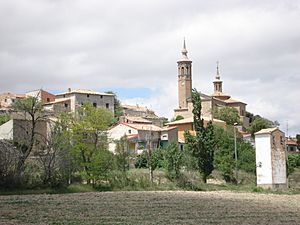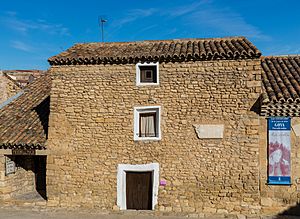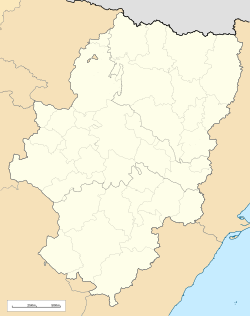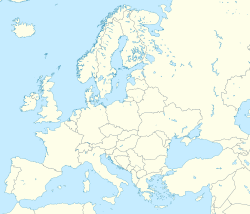Fuendetodos facts for kids
Quick facts for kids
Fuendetodos
|
|
|---|---|
 |
|
| Country | |
| Autonomous community | |
| Province | Zaragoza |
| Comarca | Campo de Belchite |
| Judicial district | Zaragoza |
| Area | |
| • Total | 62.20 km2 (24.02 sq mi) |
| Elevation | 750 m (2,460 ft) |
| Population | |
| • Total | 121 |
| • Density | 1.945/km2 (5.038/sq mi) |
| Demonym(s) | Fuendetodinos |
| Time zone | UTC+1 (CET) |
| • Summer (DST) | UTC+2 (CEST) |
| Climate | Cfb |
Fuendetodos is a small town in the Aragon region of Spain. It is located about 44 kilometers (27 miles) southeast of the city of Zaragoza. In 2011, about 178 people lived there.
This town is famous because the well-known painter Francisco de Goya was born here in 1746. Today, Fuendetodos has a museum dedicated to his amazing artwork. Nearly 25,000 people visit the town each year to learn about Goya and its history.
Contents
Geography of Fuendetodos
Fuendetodos is found in the Aragonese region called Campo de Belchite. It is about 44 kilometers (27 miles) south of Zaragoza.
In 2011, the town had 178 residents. By January 1, 2015, the population was estimated to be 144 people.
History of Fuendetodos
The town's name, Fuendetodos, means "source of all." It was founded in the 12th century as a village connected to a castle. Before that, it was known for its special "caracoleña" stone quarries. The ancient Romans used this stone for many buildings in nearby Caesaraugusta (now Zaragoza).
From the 14th century, the village belonged to the Fernandez de Heredia family, also known as the Count of Fuentes. During the Little Ice Age, a time when the Earth was cooler, the town became known for making ice.
Goya's Connection to Fuendetodos
In 1724, stones from the old castle were used to build the new Church of Nuestra Señora de la Asunción. Goya was baptized in this church. He was born in Fuendetodos almost by chance. His parents usually lived in Saragossa. But his mother was from Fuendetodos, and his father was working there. He was adding gold decoration, called gilding, to the main altarpiece (a decorated screen behind the altar) of the new church. His pregnant wife came with him, and they stayed in the town for several months. During this time, the famous painter was born.
The Pignatelly family, who were the Count of Fuentes, supported the young Goya. He created one of his first paintings in Fuendetodos, inside a sacristy cupboard. Goya also returned to Fuendetodos for safety during the Second Siege of Zaragoza in 1809. He was there to sketch the destruction caused by the French army.
Preserving Goya's Legacy
In the 1920s, another Spanish painter, Ignacio Zuloaga y Zabaleta, visited Fuendetodos to see where his hero, Goya, was born. He found Goya's birth house, bought it, and turned it into a museum. Zuloaga returned many times and even helped the town by donating money for a new school.
During the Spanish Civil War (1936–1939), Fuendetodos was taken over by Republican forces. The church, which was used as a strong point for defense, was burned. The altarpiece and Goya's other paintings inside were destroyed. Goya's birth house was also looted, and many original pieces of furniture were lost.
Goya's birth house remained a simple tourist spot until the late 1980s. Then, with Joaquín Gimeno becoming mayor, it was renovated. Since the 1990s, efforts to promote Goya's home have made Fuendetodos a popular place for tourists.
Economy of Fuendetodos
In the past, people in Fuendetodos mostly worked in rainfed agriculture (farming that relies only on rainfall) and raised sheep and goats. For hundreds of years, the special "caracoleña" stone quarries, found only in Fuendetodos, were important. The ice industry was also a big part of the economy.
The town had 22 neverones (ice refrigerators). These were used to store ice, which was then sold in the market of Zaragoza. This brought a lot of money to the town. Today, wind power production and tourism are more important. About 20,000 visitors come each year.
Vegetation and Nature
Much of Fuendetodos is covered with Alepo pine trees. These trees once belonged to the Counts of Fuentes, but now grow on town land. Holm oaks are also found on the hills.
The area also has Mediterranean scrub, called Romeral. This includes many black juniper bushes, lavender, sage, and other tough, leathery-leaved shrubs. Kermes oak trees also grow here.
Deep gorges (narrow valleys) are carved into the hard limestone rocks from the Jurassic period. These were formed by water from melting glaciers. These gorges have a surprising variety of plants, even though Fuendetodos is a dry place. You can find deciduous forests with hackberry, Montpellier maple, and turpentine tree. There are also five different kinds of ferns.
Points of Interest
Francisco de Goya's Birthplace and Museum

The birthplace of the famous Spanish painter, Francisco de Goya, was built in the early 18th century. Just a few steps away is the Museo del Grabado de Goya, which opened in 1989. This museum shows Goya's printed artworks. It has a permanent collection of his series like Los Desastres (The Disasters), Los Caprichos (The Caprices), Los Disparates (The Follies), and La Tauromaquia (Bullfighting). You can also learn about the techniques used to make these prints.
Fuendeverde Nature Space
The Fuendeverde Nature Space opened in June 2010. It helps people learn about the rich variety of plants and animals, called biodiversity, in Fuendetodos. It also shows the different types of natural areas in the town. There is a nature center with a permanent exhibit and a nature school for workshops. These are in a restored old farmhouse, built over the remains of the old castle. You can also take guided tours to beautiful natural spots nearby.
Neveras (Ice Houses)
Neveras or neverones are stone buildings used to store snow in winter. This snow would then turn into ice blocks to be sold. The ice-making industry grew a lot during the Little Ice Age, reaching its peak in the 18th century. During that time, 22 neveras were working, producing ice for the markets in Saragossa.
Their building style is special to this area. They have a pit about 6 meters (20 feet) deep and 6 meters wide. A dome-like roof was built over this pit, topped with a specially shaped large stone. Remains of neveras are found all around Fuendetodos. The Nevera de la Culroya is the only one that is still completely preserved.
- See Ice house (building)
Church of Our Lady of the Assumption
The Church of Our Lady of the Assumption was built in the 18th century. However, it had to be rebuilt in the 20th century after it was destroyed during the Spanish Civil War (1936–1939). The baptismal font, where Goya was baptized, is still kept in the church today. Before the war, the church had paintings by a young Goya in the sacristy cupboard. It also had a beautiful baroque altarpiece decorated with gold by Goya's father. This church was for the wealthy families. There was another, smaller church in the "El Calvario" neighborhood, but only parts of it remain now.
Busts of Goya
Fuendetodos has two sculptures honoring the painter. The first is a bronze bust (a sculpture of the head and shoulders) of Goya. It sits on a three-foot-high base made of rough, blue jasper stone from nearby quarries. This monument was designed in 1920 by Julio Antonio. It was paid for by Ignacio Zuloaga and his friends. Below the words A GOYA are these words: "For the spirit of the immortal artist, that the glory spread around the world, live in the town that gave birth." And below that: "This monument was erected by Ignacio Zuloaga and his friends. October 19, 1920."
The other bust was designed by José Gonzalvo Vives. It was placed in front of Goya's birthplace in 1978.
Medieval Castle Remains
The town has the remains of the medieval castle of Fuendetodos. It was built with stone after Christians took back the area in the 12th century. It was located on the western side of the town. After being abandoned, its stones were used to build the Church of Our Lady of the Assumption in the 18th century. The villagers also used its towers and walls as barns and stables. A farm built in 1979 over part of the castle is now the Fuendeverde Nature Space.
ARTEfuendetodos Gallery
The ARTEfuendetodos Gallery is a place for artists and art lovers to meet. In its four exhibition rooms, you can see works by great masters of modern art.
Fuente Vieja (Old Source)
The "Old Source" or "Source of everybody" is part of a local legend. It still provides some water, but it was restored because of its historical importance. Now, the town has a regular water supply. It has a Gothic arch door that lets visitors see the artificial cave where the water comes from. Inside the cave, there is an even older Romanic arch.
Notable people
- Francisco Goya (1746–1828), artist
See also
 In Spanish: Fuendetodos para niños
In Spanish: Fuendetodos para niños




